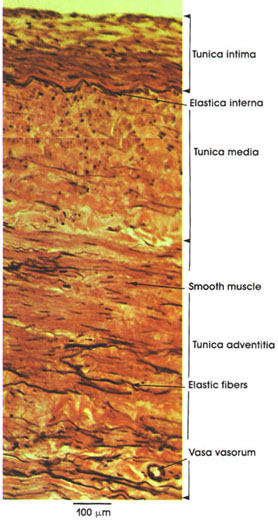

Ronald A. Bergman, Ph.D., Adel K. Afifi, M.D., Paul M. Heidger,
Jr., Ph.D.
Peer Review Status: Externally Peer Reviewed

Human, 10% formalin, Weigert's* elastic tissue stain and phloxine, 162 x.
The superior and inferior venae cavae are examples of large veins. The walls of large veins have three tunicae: intima, media, and adventitia.
The tunica intima is thick compared to that of other veins. A delicate internal elastic membrane may be seen in it.
In the tunica media, smooth muscle fibers are lacking or markedly reduced. This tunica is relatively small.
The tunica adventitia is the thickest of all tunicae. It consists of loose connective tissue and contains longitudinally arranged bundles of smooth muscle as well as thick elastic fibers. The vasa vasorum (blood vessels of blood vessels) that nourish the wall of the vein are found in this tunica and may penetrate into the media or even the intima.
*Weigert was a nineteenth-century German pathologist.
Next Page | Previous Page | Section Top | Title Page
Please send us comments by filling out our Comment Form.
All contents copyright © 1995-2025 the Author(s) and Michael P. D'Alessandro, M.D. All rights reserved.
"Anatomy Atlases", the Anatomy Atlases logo, and "A digital library of anatomy information" are all Trademarks of Michael P. D'Alessandro, M.D.
Anatomy Atlases is funded in whole by Michael P. D'Alessandro, M.D. Advertising is not accepted.
Your personal information remains confidential and is not sold, leased, or given to any third party be they reliable or not.
The information contained in Anatomy Atlases is not a substitute for the medical care and advice of your physician. There may be variations in treatment that your physician may recommend based on individual facts and circumstances.
URL: http://www.anatomyatlases.org/